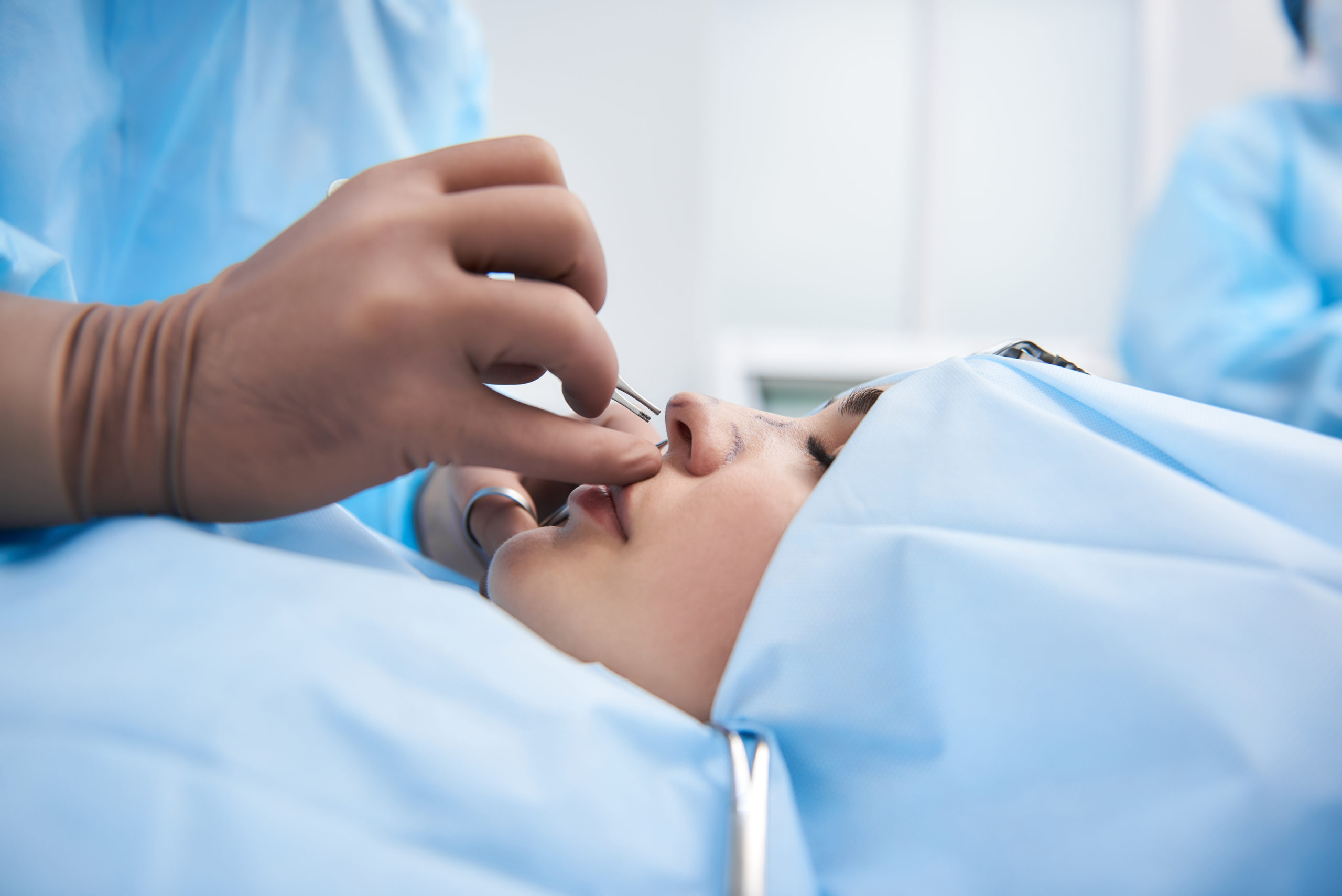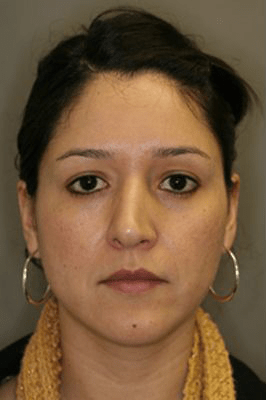Your Nose Can Look More Attractive with a RhinoplastyA rhinoplasty surgery, more commonly known as a nose-job, is designed to correct problems with the nose and provide it with a new and improved shape while also correcting functional issues. The nose is one of the most vital facial features that defines… Read More
Rhinoplasty Pasadena
Conveniently located to serve Arcadia, CA
Rhinoplasty is a cosmetic procedure that alters the outward appearance of the nose without sacrificing its function. When performed by a skilled surgeon, it reshapes the contours of the nose in a manner that brings harmony to the other facial features. Overdeveloped ridges along the dorsum (more commonly known as a dorsal “hump”), which create a bump or hook along the nose when seen from the side, maybe gently removed, and broad or misshapen nasal tips can be refined. Defects in the nose that are present after an accident, sports injury, or even at birth may be corrected. In addition, the tip of the nose often begins to droop as its structural support weakens with age. Rhinoplasty, or nasal reshaping, can assist in facial rejuvenation. Dr. Chow is well versed in both “open” and “closed” rhinoplasty techniques and can discuss how refinement of the nose may best be achieved.
Because the shape of the nose is so central to how a face looks, it should complement the natural contours of the face. Some patients benefit from concurrent chin implants at the time of nasal surgery to achieve a balanced facial aesthetic. During a consultation session with Dr. Jen Chow at this Arcadia, California rhinoplasty practice, such options may be discussed and reviewed.

Types of Rhinoplasty Surgery
- Closed rhinoplasty – In this procedure, incisions are made inside the nostrils so that scars remain hidden. However, this procedure offers limited access to the nasal structure.
- Open rhinoplasty – Just like in the closed rhinoplasty procedure, incisions are made in the nostrils, but are joined with a small incision on the columella present between the nostrils. This unveils the nose giving full access to the nasal structure.
- Reduction rhinoplasty – This is a nose surgery that involves making the nose shorter or smaller. It is also used for reducing the hump present on the bridge.
- Revision rhinoplasty – Rhinoplasty is a challenging procedure and might need some revisions to either make more changes or to correct issues that occurred from the first procedure. This procedure is called revision rhinoplasty and it can have a functional or aesthetic purpose.
Preparation
Reshaping the nose has been described in many ways, from a nose job to nose surgery to rhinoplasty. In primary rhinoplasty, the nose is surgically reshaped to a more aesthetically pleasing shape. Because of the specific concerns of those patients who desire Asian rhinoplasty or revision rhinoplasty, these topics have been addressed separately. Simply click on the name of the procedure in order to follow the link to the appropriate web page.
Before the Procedure
During your initial consultation, Dr. Jen Chow will perform a complete history and physical examination of your face and nose to determine if rhinoplasty, or nasal reshaping, is the appropriate solution for your cosmetic concerns. The two of you will then discuss the procedure in full. In many cases, the use of digital imaging to see what the nose might look like after surgery is a powerful tool that can significantly assist in communication between you and your facial plastic surgeon.
Once you have decided to have surgery, Dr. Chow will fully explain the risks and benefits of the procedure, taking the time to answer any and all questions you may have.
A thorough work-up based on your age, health history, and any risk factors you might have (previous surgery, certain habits such as tobacco use, over-the-counter nose sprays, specific vitamins, and supplements) will be reviewed. In order to be certain that you will be safe for the procedure, specific tests or a consultation with your primary care physician may be needed.
You will be provided with written instructions regarding what to do in the weeks leading up to surgery. Foods, supplements, and even vitamins that may thin the blood should be avoided. Aspirin, ibuprofen, Alleve, and other over-the-counter non-steroidal inflammatory medications (NSAIDs) should be avoided as well.
Should you have any questions prior to the procedure, you should always feel free to contact Dr. Chow. He will be more than happy to answer your questions.

The Procedure
Most of Dr. Chow’s rhinoplasty procedures are done in a fully accredited outpatient surgical facility for maximum safety. Dr. Chow also works with board-certified anesthesiologists to be certain that you are comfortable and safely monitored throughout your procedure.
You will be given specific instructions leading up to your procedure. Some helpful tips for the day of surgery include: avoiding clothing that must be pulled over the head (zippered or buttoned shirts are recommended), leaving jewelry and valuables at home, and keeping the face and hair free of makeup and hair sprays or gels, respectively.
There are two major approaches to the typical primary rhinoplasty, although there are innumerable variations of each approach. They are the closed and the open approach. Dr. Jen Chow performs nasal reshaping through the use of both techniques, when appropriate, though he does favor the open approach in many cases. Excellent results can be achieved with either technique when used appropriately.
The first and older technique is closed rhinoplasty. As its name suggests, closed rhinoplasty is performed via incisions that are made inside the nasal passages. The major advantages of this technique include the fact that no visible scar exists on the outer skin of the nose. However, visualization of the various components inside the nose is decreased accordingly.
Therefore, Dr. Chow often prefers the open, or external approach, in which almost all incisions are made inside the nose except for a small, upside-down “V” as shown in the diagram below. This incision most often heals very well, becoming all but imperceptible to others. In addition, because it is on the portion of the nose that faces downward, it is difficult to see even while healing.
Recovery Info
After the Procedure
There is some mild swelling both inside and outside of the nose after the procedure, though most patients do quite well. In some cases, there may be bruising beneath the eyes. During the first 24 hours after surgery, the application of ice may help reduce swelling and bruising.
A cast is placed over the nose for one week following surgery. This is to protect the structural changes that have been made so that they can heal while maintaining aesthetically and functionally important relationships. Once the cast has come off, avoiding contact sports and activities in which the nose may be struck is recommended for another five weeks. Avoidance of the use of glasses that rest on the bridge of the nose is also important in order to minimize injury right after surgery.
The Cost of Rhinoplasty
Rhinoplasty is a highly personalized surgical procedure that can involve the use of various techniques. The cost of your rhinoplasty procedure will vary based on the techniques used and the amount of work that needs to be done in order to provide you with the natural-looking results you desire. During your consultation, Dr. Chow will go over the expected cost of your rhinoplasty procedure and let you know about the payment and financing options we offer.
Schedule a Consultation Today
If you are bothered by the appearance of your nose and would like to be able to feel comfortable and confident with your appearance, contact our office today to schedule a consultation for your rhinoplasty. Dr. Chow is a fellowship-trained and double board-certified facial plastic surgeon who is dedicated to providing our patients with the personalized care and natural-looking results they want.
FAQ
-
What does Rhinoplasty or Septorhinoplasty mean?
The words rhinoplasty and septorhinoplasty are often used in the media and on the internet, but their actual meanings can be very confusing. The easiest way to understand what they mean is to look at the words themselves first. Rhinoplasty means nose (rhino) shaping (plasty). It is often referred to as the “nose job,” though this might be considered an outdated term. Several decades ago, surgeons approached each nose with the same formula. Having a “nose job” meant a particular appearance that was clearly the result of surgery. Many advances have been made in recent years which now enable well-trained surgeons to provide a beautifully natural appearance after rhinoplasty. This provides you with an excellent range of choices. Through the use of the latest open and closed rhinoplasty techniques, Dr. Jen Chow of Los Angeles, California can help you decide how best to achieve a beautiful and balanced nose uniquely suited to you.
Septorhinoplasty is nose reshaping with the inclusion of the middle wall that divides the nose into two nostrils which is called the septum. In many patients who also have difficulty breathing, the septum may slant into one side, blocking airflow. Dr. Chow is not only a facial plastic surgeon, but he is also board certified to assess and correct the nasal obstruction. Call or email the doctor today in order to find out if septoplasty (middle wall reshaping) will help you breathe easier.
-
Who is a candidate for rhinoplasty or septorhinoplasty (nose reshaping)?
People of all ages who want to redefine the shapes of their noses may be candidates. This includes those who have been considering corrective surgery of the nose, those with nasal obstruction, and those who want to enhance their appearance. Because the nose continues to grow and change from birth through 14-16 years of age, purely cosmetic rhinoplasty is not recommended during early childhood and the beginning of adolescence, as the nose and face are continuing to change and develop. However, as every individual is unique and changes differently, consulting a board-certified physician knowledgeable in the development of the nose is the first step to finding out if rhinoplasty, or nasal reshaping, is for you. A visit to Dr. Chow will help you make an informed decision free of undue bias.
-
How old do I have to be before I can have rhinoplasty (nose reshaping)?
Dr. Chow believes in safe, effective surgery. Since the nose grows and changes in spurts starting at birth, waiting for emotional and physical maturation is the best, safest method for ensuring long-lasting, beautiful results. This usually means ages 14-15 for girls and a little older for boys. These ranges are generalizations, of course, as each person matures differently. At the Chow Center, everyone who arrives for consultation is treated as an individual with a unique plan of care.
-
How old is too old to have rhinoplasty?
As long as you are in good physical and mental health, age should not exclude you. In fact, rhinoplasty in those aged 40-60 is common. Dr. Chow has been involved with patients in their seventies at the time of their nose surgery.
-
Which nose shape is best for me?
There is no single ideal shape for the nose. Gender, ethnicity, culture, personal preference, height, facial features such as the chin and forehead, function (breathing), and even fashion affect the ideal shape for a nose. Each nose is unique and requires a carefully planned procedure to reshape it in an attractive, appropriate way. With the help of computer imaging, Dr. Chow can provide you with an image enhancement session to show you what your new nose might look like. This allows you to guide the process and see the best nose shape for you.
-
What parts of my nose can be changed with rhinoplasty or septorhinoplasty (nose reshaping)?
Nearly all of your nose may be changed. However, there are limitations, many of which are based on maintaining the primary function of your nose, which is to filter, warm, and humidify the air as you breathe. Making a nose too small or even too big can impair this function. Therefore, choosing a board-certified surgeon who understands both the art and science of cosmetic and functional rhinoplasty is extremely important. Call Dr. Chow today at (626) 447-3223 to schedule a consultation, or email him at info@chow.md for more information.
-
My nose is too big. Can you make it smaller?
Yes. In addition, Dr. Jen Chow can assist patients with noses that are too short, too long, too narrow, or too wide. He also has experience correcting twisted or crooked noses. However, the natural shape of the face must be complemented by the nose. By discussing your concerns with Dr. Chow in person, you can learn more about the options available to you.
-
My nose is too small. Can you make it bigger?
Yes, particularly if your nose has a low bridge (the part of your nose where your sunglasses sit) that you would like augmented. Again, the natural shape of the face should be complemented by the nose. A higher bridge can make glasses fit better and provide a pleasing, harmonious relationship with the brow, eyes, and chin. At the Chow Center in sunny Southern California, everyone interested in rhinoplasty has access to an image enhancement session, in which computer imaging is used to approximate how rhinoplasty would affect your face.
-
Do you do computer imaging?
Yes, Dr. Chow has access to the latest software and hardware for computer imaging. You can learn more about digital imaging here. In real-time, he can show you how your nose might change after rhinoplasty, or nose surgery. These image enhancement sessions serve as a helpful tool in communicating common surgical goals. However, computer-generated images do not serve as a guarantee and are used only to help the patient and surgeon understand how the nose might look after surgery.
-
Do I have to stay overnight in the hospital after my rhinoplasty?
In the vast majority of cases, you will be able to go home after surgery. If you are from out of town, you should spend the first night after surgery in a nearby hotel so that Dr. Chow may see you the next morning.
-
What kind of anesthesia is used?
Dr. Chow has performed rhinoplasties with multiple different types of anesthesia. One form is commonly called twilight sedation. This allows patients to snooze comfortably while surgery is performed. Patients are able to breathe on their own without a machine and tend to wake more quickly with less nausea than when general anesthesia is used. However, as each individual has unique needs and concerns, the type of anesthesia used will depend on your general state of health. In addition, Dr. Chow has an anesthesiologist present during all of his surgeries so that his attention may be focused solely on the patient, rather than split between the procedure, the monitors, and the medications necessary to keep you safe and comfortable.
-
I’ve heard that it can take a year to see my final results. Is this true?
Yes, this is true. The nose continues to evolve in the months after surgery. Because the nose contains not only the outer skin and soft tissue but is also supported by an intricate combination of cartilage and bone, subtle changes occur over time as these structures heal. Usually, the final result from rhinoplasty can only be assessed after a year has passed. However, as the year progresses, Dr. Jen Chow is often able to help shape the healing process. For this reason, he recommends periodic visits after surgery within the first year to make certain your nose is healing well.
Related Posts
Asian Rhinoplasty: Reshape Your Nose Without Changing Your Overall LookA lot of people choose to have Asian Rhinoplasty, but a great deal of care must be exercised to retain the unique features of the Asian nose. A Rhinoplasty is a surgical procedure that can be used to improve the aesthetics and function of one’s nose. The Asian… Read More
Asian Rhinoplasty Enhances the Nose While Preserving Aesthetic Cultural IdentityRhinoplasty helps to reshape the nose and give it a better and more attractive shape and overall appearance. During rhinoplasty, it is important to retain certain nasal features intrinsic to the patient’s culture, race, and ethnicity; too many changes will… Read More
Related Links



